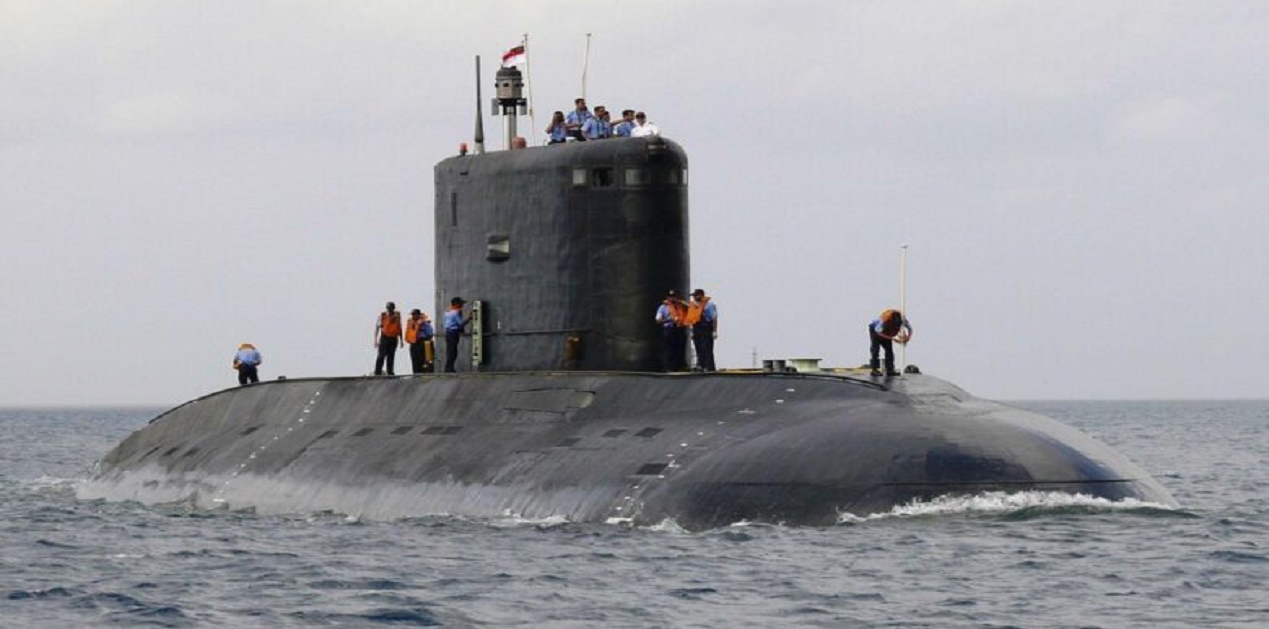India is gifting a Russian Kilo class submarine to Myanmar1. The diesel-electric submarine, INS Sindhuvir, was inducted in the Indian Navy in 1988 and continues to be in service. The submarine refurbished by the Hindustan Shipyard Ltd a Defense PSU, even today boasts of world class capabilities of stealth, weapon and sensors. This would be a very capable first submarine for Myanmar as it likely prepares to procure more Kilo class submarines from Russia. Myanmar’s plan to buy submarines from Russia may be influenced by the fact that its neighbour Bangladesh inducted two Ming-class diesel-electric submarines from China in 20162.
The transfer of the submarine is a show of India’s intent of pursuing its vision of SAGAR (security and growth for all in the region), a commitment to build capacities and self-reliance in all neighbouring countries3.
Myanmar is the only Southeast Asian country with which India shares a land border and is therefore a key pivot to its 'Act East' policy and a gateway to Southeast Asia. The two countries also share a 725 km maritime boundary in the Bay of Bengal.
Analysts see the transfer of submarine as a move by Delhi to counter China’s clout in the region4, which could be considered a parochial outlook considering that this is a part of the larger SAGAR vision advocated by PM Modi. It is a reflection of India’s traditionally non-expansionist and inclusive approach for collective good, deeply ingrained in its strategic outlook espoused by its ancient culture and articulated as Vasudhaiv Kutumbakam (the world is one family).
What is of significance is the fact that India in the last fifteen years5 has been able to induct only two submarines i.e. in the years 2017 and 2019 – the P75 class conventional submarines viz. Kalvari and Khanderi. Yet, in spite of a shortage of submarines in its own inventory; and what with the aggressive and expansionist military actions of China across all its borders including in north eastern Ladakh; India has offered a critical asset from its inventory to its neighbour over its own maritime security requirements.
Maritime Security in the Neighbourhood
In the effort to secure the proximate sea lanes from both traditional and non-traditional threats, India has been for decades providing, among other things, assistance in terms of capacity and capability building, and cooperative security mechanisms, to the small and vulnerable island nations of Maldives, Mauritius, Seychelles and also to Sri Lanka. These island nations lie close to the critical sea lanes that traverse the region and Maldives and Sri Lanka lie particularly close to the Indian land mass.
In terms of enabling these countries to strengthen their maritime security and preserve their strategic autonomy, India has provided them with military assets including platforms such as offshore patrol vessels, fast interceptor boats, water jet fast attack crafts (WJFAC), Dornier maritime patrol aircraft and HAL made advanced light helicopters. Capacity building has also been facilitated through support in the form of spares, technical maintenance assistance and training of personnel and military infrastructure development6 In recent times, an Offshore Patrol Vessel (OPV) Barracuda, constructed by Goa Shipyard Ltd and partially funded by India was delivered to Mauritius Coast Guard in 2015. Two WJFACs were also supplied in 2016 and 2017. Similarly, in 2017 and 2018 India supplied two advance OPVs, specifically constructed for the Sri Lankan Navy viz. Sayurala and Sindhurala
.
Providing an all round coastal surveillance bubble, India has also set up a five-station Coastal Surveillance Radar System (CSRS) at Mauritius in 2012, an eight-station CSRS at Seychelles in 2015 and a six-station automatic identification system (AIS) at Sri Lanka. India has also installed a10-station CSRS at Maldives and has inked agreements to install CSRS in Bangladesh and Myanmar in the near future7.
India, Maldives and Sri Lanka have also signed a Trilateral Maritime Security Cooperation Agreement in 2013. India has also deepened its ties with Mauritius and Seychelles, which was bolstered by Indian Prime Minister Narendra Modi’s 2015 visit.8
India has institutionalised coordinated maritime patrols with countries that share maritime boundary with India in the Bay of Bengal9. Also, EEZ Surveillance is provided to the small island nations viz. Maldives, Mauritius and Seychelles for augmenting their maritime security efforts by deploying Indian aircraft and ships for the purpose10.
For providing a real-time, collated, fused and actionable information for building the Maritime Domain Awareness (MDA) for partners in the region, India Navy has set up Information Fusion Centre-Indian Ocean Region (IFC-IOR) in Gurugram in December 2018. Towards capability building, the IFC-IOR would also conduct training in maritime information collection and sharing and is likely to host international liaison officers from partner nations, which should expand to include Southeast Asian littorals in the near future.11 This information sharing mechanism through a common maritime picture is a big enabler for smaller countries for proactively addressing both traditional and non traditional security threats including piracy.
India has always come to rescue of the small and vulnerable archipelagic island nations of Maldives during crises, be it ‘Operation Cactus’ during the failed1988 coup attempt; during the 2004 tsunami; or during the water crisis in December 2014 when Male’s sole desalination plant was gutted by a fire. Indian naval ships on deployment carrying humanitarian assistance and disaster relief (HADR) ‘Bricks’, have also been first responders for disaster relief requirements in the region. 12
Having jumped into the Belt and Road Initiative (BRI) bandwagon with China in 2014, Maldives today finds itself buried in debts to China amounting to US$1.4 billion, representing 38% of the country’s national debt. This leaves it very vulnerable to Chinese influence. However with Ibrahim Mohamed Solih; a leader who views and values India as an ally; coming to democratic power in September 2018, New Delhi has been able to further its assistance to Maldives – India has provided an Indian-built coast guard vessel and promised development projects, including fish processing plants, a cancer hospital and a cricket stadium in Hulhumale. New Delhi in December 2018 also promised a $1.4 billion credit line and budgetary support, which incidentally equals the amount the country, owes China. In June 2019, Modi and Solih inaugurated the Indian-built Coastal Surveillance Radar System and a composite training facility for the Maldivian National Defence Force13. As a consequence of the COVID pandemic however, the island nation has again been pushed on the brink of a crisis as its economy, almost completely dependent on tourism, has come to standstill.
The economic dependencies and debt trapping orchestrated by China in these small island nations; particularly those that lie along China’s envisaged Maritime Silk Route; in the name of infrastructure development and investments; is complicating and compromising the maritime security in the region. China’s has wrested a 99 year lease14from Sri Lanka that gives it ownership of the Hambantota port in Sri Lanka raising uncertainties and complicating the security situation in the proximity of India. Emergence of non traditional security issues spawned by increased Chinese presence in the area can also be expected in the region in future.
Myanmar
Assistance to Myanmar is therefore a natural progression of India’s endeavours towards the East–in the region surrounding Malacca straits, accelerated by the recent aggressive and expansionist activities of China along the Indian borders in Eastern Ladakh and also in the South and East China Seas. Signals are evident from the China’s push to build deep seaports in Bangladesh and Myanmar for obtaining a greater foothold in Bay of Bengal. However Bangladesh has so far (in November 2019) pledged to Beijing only the use of two major ports of Chittagong and Mongla for trade. This commitment was made just weeks after Dhaka signed an agreement with New Delhi for access to the same ports, including for sending goods to India’s North Eastern states15. There are also plans to construct a submarine base in Cox's Bazar with China's help16.
The Chinese BRI infrastructure projects in Myanmar which include building a deep-water port in Kyaukphyu for connecting China's Yunnan Province to the Bay of Bengal through a network of road, rail and pipelines has been reined in by Myanmar to an extent in that the original cost of Kyaukphyu SEZ (which is a part of China-Myanmar Economic Corridor or CMEC) was slashed from $ 7.2 Billion to $ 1.3 billion by Myanmar over concerns of excessive debt. Other Chinese projects such as the Letpadaung Copper Mine and Myitsone Dam project are also embroiled in environmental issues and protests by local populace17.
Since the military coup in Myanmar in 1962, India had hardly any engagement with the country till the 1990s when there was a perceptible shift when India announced its ‘Look East’ policy. India decided to engage with whichever incumbent regime was in power in order to further its relations with Myanmar.18 During the period of sanctions by the West in the 1980s and 1990s, China was actively involved in heavy investment, loans, credits and arms sales in Myanmar and eventually became its largest trade partner. China’s developmental and technical assistance was mainly in sectors such as hydropower, mining, oil and gas which benefitted the military regime but had an adverse effect on the average citizen19. China’s influence has slightly waned after the Myanmar government implemented political reforms in 2011 and as the West started re-engaging with the country.20 Limited transparency in Chinese Communist Party’s economic dealings, lack of concern for national sentiments, indiscriminate exploitation of natural resources and the local populace have resulted in deep distrust and anxiety among the people of Myanmar against the Chinese21. Myanmar government therefore wants to reduce its over-reliance on China and diversify its economic dealings and military equipment which it largely used to buy from China.22
India has since, involved itself in major projects such as connecting Moreh in India with Mae Sot in Thailand via Myanmar and the Kaladan multimodal transit and transport project that aims to connect Kolkata with Sittwe port in Myanmar which would ultimately provide connectivity with Mizoram via inland waterways and land route23.
India recently in July 2019 signed a MoU with Myanmar to strengthen military ties in the fields of training, joint surveillance, maritime security etc. As per a $37.9 million contract, India recently delivered indigenously built light torpedoes to Myanmar Navy. In March 2018 Indian and Myanmar navies conducted a maiden joint exercise in the Bay of Bengal (INMEX)24.Myanmar Navy has also contracted for Indian made anti-submarine warfare suit for its Kyan Sittha-class frigates25.
The Indian Navy has also been undertaking coordinated patrols with Myanmar in the Bay of Bengal since 2013 to overcome the maritime challenges of human smuggling, trafficking and illegal, unreported and unregulated (IUU) fishing26.
Conclusion
The ability of small nations in the region to take sovereign decisions and actions in the interest of global commons, free from the influence of economic arm twisting or enticements, particularly from China, will play a key role in securing the safety of sea lanes in the region. This requires incremental augmentation of security, infrastructure and economic capacities of small island nations in the region.
Indian activities in its maritime neighbourhood can be seen as aiming to preserve the economic, political and territorial sovereignty of these small countries and gravitate more towards collective capacity and capability building for ensuring a free, open and rule based conduct in the seas - a global common.
Echoing the sentiments of K.M. Panikkar, renowned Indian strategist and diplomat, 'To defend Burma is to defend India'27, India’s assistance to Myanmar is a natural progression of its endeavours towards the East.
The gifting of a submarine to Myanmar is just the start of a capability building activity and needs to be followed up with a detailed plan for providing it a life cycle support – in terms of maintenance, training, spares, periodic overhauls, dock availability, and above all a corresponding budget, in order to truly translate the act of transferring a valuable asset into a tangible and realistic capability.
It needs no reiteration that, similar actions need to be replicated incrementally in other island nations in India’s neighbourhood, particularly those vulnerable to external power influences, for seamless security of sea lanes and maritime security in the region, in pursuance of the SAGAR vision of collective growth for all in the region.
Endnotes
- The Print, 15 Oct 20, https://theprint.in/defence/india-to-deliver-kilo-class-submarine-ins-sindhuvir-to-myanmar-navy/524450/,accessed on 22 Oct 20.
- Nikkei Asia, ‘With an eye on China, India gifts submarine to Myanmar’, 22 Oct 2020, https://asia.nikkei.com/Politics/International-relations/With-an-eye-on-China-India-gifts-submarine-to-Myanmar, accessed on 23 Oct 20.
- MEA Website, https://mea.gov.in/media-briefings.htm?dtl/33125/transcript+of+virtual+weekly+media+briefing+by+the+official+spokesperson+15+october+2020, accessed on 20 Oct 20.
- Nikkei Asia,22 Oct 2020, n.2.
- Standing Committee on Defence (SCOD) report of Mar 2020 to Lok Sabha for Demand for Grants 2020-21.
- Roby Thomas (2020): Leveraging India’s Maritime Diplomacy, Journal of Defence Studies, Vol. 14, No. 3, July-September 2020, pp. 1-27
- Ibid.
- Dr Sripathi Narayanan, Big Picture: India and the US-Maldives Defence Agreement, Institute of Peace and Conflict Studies, 23 Sep, 2020, http://www.ipcs.org/comm_select.php?articleNo=5726, (accessed on 24 Oct 2020)
- Roby Thomas (2020), n.6.
- Indian Navy website, https://www.indiannavy.nic.in/content/eez-surveillance-seychelles-and-mauritius, accessed on 21 Oct 20.
- Roby Thomas (2020), n.6.
- Dr Sripathi Narayanan, 23 Sep 2020, n.8.
- Bertil Linter, Quarantined Maldives requires China to survive, Asia Times, 27 Mar 2020, https://asiatimes.com/2020/03/quarantined-maldives-needs-china-to-survive/ (accessed on 23 Oct 20)
- Maria Abi-Habib ‘How China Got Sri Lanka to Cough Up a Port”, New York times, June 25, 2018, https://www.nytimes.com/2018/06/25/world/asia/china-sri-lanka-port.html (accessed on 23 Oct 20)
- Bertil Lintner, Bangladesh wins and loses in China-India rivalry, 14 Oct 2020, Asia Times, https://asiatimes.com/2020/10/bangladesh-wins-and-loses-in-china-india-rivalry/ (accessed on 23 Oct 20)
- Nikkei Asia, 22 Oct 2020, n.2.
- Ravi Shankar, ‘Understanding ‘PaukPhaw’:Can Myanmar Resist China’s Debt Trap’, Bharat Shakti, 11 Oct 20, https://bharatshakti.in/understanding-paukphawcan-myanmar-resist-chinas-debt-trap/ (accessed on 23 Oct 20)
- Conference Report, India-Myanmar Relations-Looking from the Border, 28 -29 September 2015, Institute of Social Sciences and Burma Centre Delhi, https://in.boell.org/sites/default/files/india-myanmar_relations_looking_from_the_border.pdf, accessed on 20 Oct 20.
- Conference Report, India-Myanmar Relations-Looking from the Border, 28 -29 September 2015, n.18, p.73.
- Bertil Lintner, China, India tensions put Myanmar in the middle - Asia Times, 29 May 2020, https://asiatimes.com/2020/05/china-india-tensions-put-myanmar-in-the-middle/ (accessed on 23 Oct 20)
- Ravi Shankar, 11 Oct 20, n.17.
- Nikkei Asia, 22 Oct 2020, n.2.
- Conference Report, India-Myanmar Relations-Looking from the Border, 28 -29 September 2015, n.18, p.39.
- Dr Sampa Kundu, ‘India and Myanmar: Analysing the Recent Trajectory’, 08 Nov 2019, https://thekootneeti.in/2019/11/08/defence-cooperation-between-india-and-myanmar-analysing-the-recent-trajectory/ (accessed on 23 Oct 2020)
- Roby Thomas (2020), n.6.
- Ibid.
- Conference Report, India-Myanmar Relations-Looking from the Border, 28 -29 September 2015, n.18, p.84.
(The paper is the author’s individual scholastic articulation. The author certifies that the article/paper is original in content, unpublished and it has not been submitted for publication/web upload elsewhere, and that the facts and figures quoted are duly referenced, as needed, and are believed to be correct). (The paper does not necessarily represent the organisational stance... More >>
Image Source: https://secureservercdn.net/198.71.233.254/bmb.1a0.myftpupload.com/wp-content/uploads/2020/04/Indian-kilo-class-submarine-780x470.jpg











Post new comment